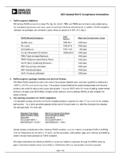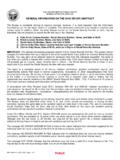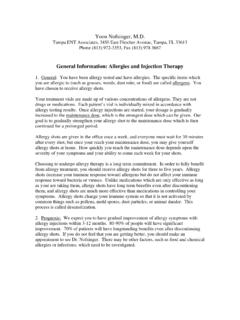Transcription of Heater Products General Information - Emerson
1 1 This section provides basic Information for the design and selection for the proper Nelson heat trace Products for pipe and vessel heating specify components for an effectively designed, totally electric heat trace system, it is necessary to understand the basic principles involved. A heat trace system is designed to replace heat lost through the thermal insulation from equipment in the system. In some applications, heat tracing will also be able to provide enough heat to significantly change the process always recommends the use of thermal insulation since heat loss from bare surfaces is very high and heat transfer between the Heater and the pipe/vessel is highly variable. All insulation should be weatherproofed. Wet insulation is ineffectual and Heater output is insufficient to dry Heating Cable ProductsNelson supplies several distinctively different types of electric heaters - Self Regulating, Constant Wattage, Mineral Insulated and VH Tank Heating Panels.
2 Each type has its own characteristics, often making one more suitable for a certain application than the others. It is important to determine whichSelf Regulating Heater CableSelf Regulating Heater Cable will adjust its own output in response to pipe temperature. Available in a variety of temperature and power ratings up to 230 C (450 F) and (20w/ft.). Product features include: Variable Output Self-Regulating heaters will react to variations in temperature encountered at every point along its length. Colder sections receive more heat output, while warmer sections receive less. This provides greater energy efficiency and more uniform pipe temperatures. Can Be Overlapped Without Damage Because Self-Regulating heaters controls its own output, overlapped sections produce less heat, eliminating hot spots and possible burn-through common with other types of cable.
3 Fail Safe Upon reaching the upper limits of its temperature range, Self-Regulating heaters diminishes its own heat output to an insignificant level. This guarantees that maximum temperatures (T ratings) cannot be exceeded no matter what product is used in any application. Easy Installation Because of its infinite parallel path circuitry, Self-Regulating heaters can be cut to any length in the field without affecting the heat output or creating dead zones .Constant-Wattage Heater CableConstant Wattage Heater Cable is a parallel resistance Heater that produces the same watts-per-foot of heat along its entire length. Easy Installation Constant-Wattage heaters can be cut to length and terminated in the field. Economical Provides good power densities and exposure temperatures with parallel circuit cable capabilities at economical prices.
4 Exposure Temperatures to +204 C (+400 F). Ideal for maintaining many process temperature Insulated Heater CableMineral insulated Cable is a series conductor, high temperature Heater cable with a special, thin metal sheath. Some of MI advantages are: Corrosion-Resistant Alloy 825 sheath provides excellent corrosion resistance and immunity from chloride stress corrosion - a common problem with stainless steel. Ideal for High Temperature Applications Mineral Insulated heaters can withstand exposure temperatures up to 593 C (1100 F). Exposure temperatures can be increased to 750 C (1400 F) with special components. Ratings To 600V Mineral Insulated heaters are available in a variety of voltages to match the available power supply. High Heat Output Mineral Insulated heaters have heat output ratings up to 10 times higher than most other cables, reducing the amount of cable required.
5 Rugged Construction A durable metal sheath provides greater mechanical protection. Thin Wall Construction A unique manufacturing process allows thin wall cable construction for easier field Tank Heating Panels Low Cost Installation Flexible silicone construction allows panel to conform to tank wall. No bonding or heat transfer aids are required. High Temperature VH Tank Heating Panels maintain temperatures up to 79 C (175 F) and can withstand exposure to 204 C (400 F). Visit our website at or contact us at United States: (800) 621-1506 | Europe: + September 2017 Heater Products General Information 2 Heat Trace Considerations1. Types of Heater ControlThere are two types of temperature control, ambient (air sensing) and line sensing.
6 On small projects either of these types of control is achieved with individual component temperature larger projects, it may be advantageous in terms of cost and maintenance, to use larger central control cabinets with electronic Effects of Heat thermally conductive material that penetrates though the insulation pulls heat away from the pipe or vessel at a high extra Heater is not installed at these points, the system will becolder in those areas. Self-regulating heaters also require extra cable at those Heat-Up loss tables do not include adequate power to provide rapid heat up of pipes or vessels filled with product. If heat-up is required, extra heat must be added. This is often accomplished by using extra heaters that are turned on only in heat-up Hazardous Area Design installed in hazardous (classified) areas must have sheath temperatures that do not exceed the ignition temperature of the hazardous gas or dust that is present.
7 The method of limiting this temperature varies with different types of Products : Self-regulating heaters may be used based on their maximum T Rating. Under no conditions will the Heater cable exceed those temperatures. Constant-wattage heaters, mineral insulated heaters and VH tank heaters, must be designed not to exceed the ignition temperature. For classified areas, this is achieved by limiting the watt density in the design so the Heater s sheath temperature will not exceed the required Heater installed in a hazardous area must have a metal shield or sheath. This provides an effective return ground path as well as providing added physical connections and remotely located control equipment should meet the criteria for hazardous area application.
8 Types of Heater ControlLine Sensing ControlLine sensing control means a thermostat or controller is used to sense each pipe or vessel s actual temperature. The Heater is only energized when that line s temperature drops below the thermostat s switching point. When controlling a Heater circuit that has both flowing and non-flowing segments, the sensor should be put on the non-flowing branch of the circuit. On critical temperature control processes, separate Heater circuits may be required. Advantages of this system include close temperature control and minimum energy usage. Disadvantages are initial control and maintenance costs that will rise in proportion to the number of controllers used. Ambient Air ControlAmbient control means the Heater is turned off and on depending on the temperature of the surrounding air.
9 This system uses an ambient air sensing thermostat or controller that may turn on an entire panel load of heaters when the air reaches a predetermined temperature (40 F is a typical value). When energizing multiple Heater loads, a contactor is used to perform the actual switching. Advantages of ambient control include simplified control wiring and lower control maintenance costs. Disadvantages include loss of precise temperature control and excessive energy consumption (heaters may be on when pipe is being warmed from Products flowing through it).Visit our website at or contact us at United States: (800) 621-1506 | Europe: + September 2017 General Design Considerations 35. Nonmetallic SurfacesNonmetallic pipes and vessels often have low softening and melting points.
10 Care must be taken in design not to let the surface or Heater reach that temperature. LT and CLT series cables can be used safely without concern. Other cables must use the following precautions: Use thermal over limit protection Use metal foil tape over and under (sandwiching) the Heater cable Limit wattage design so cable sheath temperature will not reach the pipe softening Designing Self-Regulating Heater Cables for Plastic Pipe Plastic pipe is not thermally conductive. Although the self-regulating Heater cable will itself get hotter in relation to a given pipe temperature, less heat is transferred to plastic pipe than metal pipe. Use Table 8 to determine the correct output of self-regulating Heater cable when used on plastic are three methods of applying Heater cable to plastic pipe: Regular attachment at one foot intervals Attachment of cable at one foot intervals with no heat sinking.
















